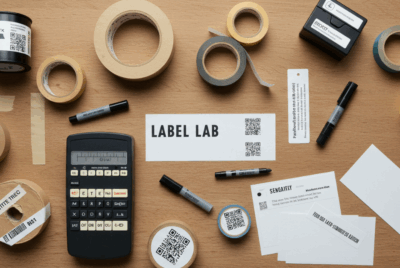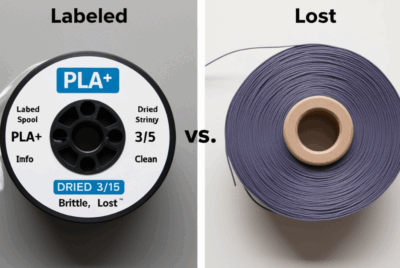Can Vacuum-Sealed Bags Be Used for Storing Multiple Filament Spools?
Storing multiple filament spools in a single vacuum-sealed bag is a practical idea, especially if you’re trying to save space or keep your filament collection organized. However, there are several factors to consider before you go ahead with this method. Let’s explore the advantages and challenges of vacuum-sealing multiple filament spools in one bag, and how to do it effectively.
1. Space Efficiency
- How It Works: One of the key advantages of vacuum-sealing is its space-saving capability. If you’re storing multiple filament spools, vacuum-sealing can compact the spools into a smaller area by removing air and moisture.
- Why It Matters: Vacuum-sealing can be an effective solution when you need to store several spools in a small space, especially if you’re dealing with a large filament collection and limited storage room.
- How to Do It: Place multiple spools into a larger vacuum-sealing bag and use the vacuum sealer to remove as much air as possible, ensuring the bag stays tightly sealed. This method can significantly reduce the overall storage space needed.
- Benefit: For smaller collections, or when you have limited storage space, vacuum-sealing multiple spools in a single bag helps maximize space efficiency while keeping the filament protected.
2. Risk of Spool Deformation
- How It Works: Vacuum-sealing multiple spools in a single bag can exert pressure on the spools, especially if the bag is tightly sealed or the vacuum pressure is too high.
- Why It Matters: Excessive pressure may lead to spool deformation, causing the filament to become difficult to use or feed into the printer. Spools can become flattened, warped, or tangled, affecting the usability of the filament.
- How to Do It: To avoid damaging the spools, make sure to leave some space in the bag so that the spools are not tightly compressed. Opt for a moderate vacuum pressure to remove air without applying too much pressure.
- Benefit: Avoiding over-compression ensures that your spools retain their shape and remain easy to handle when it’s time to use them.
3. Managing Different Filament Types
- How It Works: Different filament types (e.g., PLA, Nylon, TPU, ABS) may have unique storage needs. Some filaments, like Nylon or TPU, are more moisture-sensitive than others and require extra care when storing.
- Why It Matters: Storing different types of filament together in the same vacuum-sealed bag could lead to cross-contamination of moisture levels or affect the overall quality of the filaments, especially if the desiccant inside the bag is not sufficient to protect all spools.
- How to Do It: If you want to store different types of filament together, use desiccants like silica gel to absorb moisture and ensure proper humidity control. Alternatively, consider sealing each type of filament in its own vacuum-sealed compartment inside the same bag.
- Benefit: Proper moisture control ensures that each type of filament stays dry and usable, even when stored together.
4. Vacuum-Sealing and Filament Tangling
- How It Works: When storing multiple spools in a single vacuum-sealed bag, the filament could become tangled if the spools are not arranged properly.
- Why It Matters: Tangling can make it difficult to feed filament into your printer, leading to printing issues or wasted time spent untangling the filament before use.
- How to Do It: Arrange the spools neatly inside the bag and make sure the filament is properly wound on each spool. Consider using spool holders or filament guides to prevent tangling when packing multiple spools into a single bag.
- Benefit: A well-organized bag will make the filament easier to access, reducing the risk of tangling and making it more convenient to use multiple spools.
5. Vacuum-Sealing Large Spools
- How It Works: Larger filament spools (e.g., 2.5 kg or more) may not fit easily into standard vacuum-sealing bags, especially if you’re storing multiple spools in one bag.
- Why It Matters: For larger spools, a vacuum-sealing bag that’s too small may not provide an effective vacuum or may risk damaging the spools due to excessive compression.
- How to Do It: For larger spools, opt for larger vacuum bags that can accommodate the size of the spools without over-compressing them. If necessary, use a customizable bag roll to create a larger bag that fits the spools comfortably.
- Benefit: Using appropriately sized bags ensures that large spools can be stored effectively without risk of deformation or ineffective vacuuming.
6. Sealing Multiple Spools Without Sacrificing Moisture Control
- How It Works: When vacuum-sealing multiple spools in one bag, you need to ensure that moisture control remains effective across all spools.
- Why It Matters: Moisture-sensitive filaments like Nylon or TPU need extra care when it comes to preventing moisture absorption. If the moisture control inside the bag is not evenly distributed, some spools may not be properly protected.
- How to Do It: Add separate desiccant packs for each spool, or place a larger desiccant pack inside the bag to absorb excess moisture. You may also want to check the seal and ensure there’s no air leakage that could compromise the protection.
- Benefit: Proper moisture control prevents filament degradation, ensuring that each spool stays dry and ready for use.
7. Vacuum-Sealing for Long-Term Storage vs. Short-Term Use
- How It Works: Vacuum-sealing is generally best for long-term storage rather than short-term access. Storing multiple spools in one bag can be efficient for long-term protection, but if you need frequent access to filament, it may be more practical to store each spool in its own bag.
- Why It Matters: If you’re storing filament for an extended period and don’t need immediate access to it, vacuum-sealing multiple spools in one bag is an efficient method. However, if you plan on using the filament regularly, individual bags may be a better option for easy access.
- How to Do It: If you’re using the vacuum-sealed bags for long-term storage, consider sealing multiple spools in one bag, but for active use, store each spool in its own bag to avoid the need to open multiple bags.
- Benefit: Vacuum-sealing multiple spools for long-term storage helps save space, but for frequent use, individual bags provide easier access.
Summary of Best Practices for Vacuum-Sealing Multiple Filament Spools:
- Ensure Proper Bag Size: Use a bag that accommodates the size of your spools without over-compressing them.
- Avoid Over-Compression: Don’t apply too much vacuum pressure to prevent deformation or tangling.
- Use Desiccants for Moisture Control: Place desiccant packs inside the bag to protect all spools from moisture.
- Arrange Filament Neatly: Keep spools organized to avoid tangling and make filament easier to use.
- Use Larger Bags for Larger Spools: Ensure the vacuum bag is large enough for 2.5 kg or larger spools without compressing them.
- Store for Long-Term Protection: Vacuum-sealing multiple spools works best for long-term storage. For active use, individual bags may be more practical.
Conclusion:
Vacuum-sealing multiple filament spools in one bag is a space-efficient and cost-effective method for long-term storage. However, it requires careful attention to bag size, compression, and moisture control to ensure that the filament is protected from damage. If you’re storing filament for a longer period and don’t need frequent access, vacuum-sealing multiple spools can be an excellent option. For active printing, consider storing individual spools in separate bags for easy access and better moisture control.




